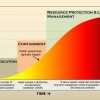 South Florida has more than its share of invasive plants, reptiles, amphibians, fish, mammals, birds, and invertebrates. Nonnative species often spread quickly. Research and monitoring can help managers anticipate which species will cause harm before it is too late to remove them. Identifying where a species is on the invasion curve is the first step to taking management action. The invasion curve shows that eradication of an invasive species becomes less likely and control costs increase as an invasive species spreads over time. Prevention is the most cost-effective solution, followed by eradication. If a species is not detected and removed early, intense and long-term control efforts will be unavoidable. This 4-page fact sheet was written by Rebecca G. Harvey and Frank J. Mazzotti, and published by the UF Department of Wildlife Ecology and Conservation, November 2014.
South Florida has more than its share of invasive plants, reptiles, amphibians, fish, mammals, birds, and invertebrates. Nonnative species often spread quickly. Research and monitoring can help managers anticipate which species will cause harm before it is too late to remove them. Identifying where a species is on the invasion curve is the first step to taking management action. The invasion curve shows that eradication of an invasive species becomes less likely and control costs increase as an invasive species spreads over time. Prevention is the most cost-effective solution, followed by eradication. If a species is not detected and removed early, intense and long-term control efforts will be unavoidable. This 4-page fact sheet was written by Rebecca G. Harvey and Frank J. Mazzotti, and published by the UF Department of Wildlife Ecology and Conservation, November 2014.
http://edis.ifas.ufl.edu/uw392
Tag: Invasive Species — General
Floridians' Perceptions of Invasive Species
 Invasive species are a serious threat in Florida. Invasive species are defined as non-native or exotic organisms, which cause ecological or economic harm or negatively affect human health in a new environment where they are not historically found. This 5-page fact sheet summarizes Florida residents’ perceptions, concerns, and knowledge about invasive species. This information will equip Extension faculty to more effectively communicate and educate clientele on this topic. Written by Nicole M. W. Dodds, Mary Hannah Miller, and Alexa J. Lamm, and published by the UF Department of Agricultural Education and Communication, October 2014.
Invasive species are a serious threat in Florida. Invasive species are defined as non-native or exotic organisms, which cause ecological or economic harm or negatively affect human health in a new environment where they are not historically found. This 5-page fact sheet summarizes Florida residents’ perceptions, concerns, and knowledge about invasive species. This information will equip Extension faculty to more effectively communicate and educate clientele on this topic. Written by Nicole M. W. Dodds, Mary Hannah Miller, and Alexa J. Lamm, and published by the UF Department of Agricultural Education and Communication, October 2014.
http://edis.ifas.ufl.edu/wc186
Why is your cup of coffee so expensive? Because of a tiny bark beetle!
 Sometimes an insect pest attacking crops in places as far away as Indonesia or Ethiopia can be very important to us here in Florida. One such insect is the coffee berry borer, Hypothenemus hampei Ferrari (Coleoptera: Curculionidae: Scolytinae), a tiny (1.5 mm) bark beetle that originated in the highlands of central Africa. It would probably remain one of the many inconspicuous little beetles in the tropics, if not for the choice of its host: seeds of several Coffea species. This 3-page fact sheet was written by Jiri Hulcr, and published by the UF Department of School of Forest Resources and Conservation, October 2013.
Sometimes an insect pest attacking crops in places as far away as Indonesia or Ethiopia can be very important to us here in Florida. One such insect is the coffee berry borer, Hypothenemus hampei Ferrari (Coleoptera: Curculionidae: Scolytinae), a tiny (1.5 mm) bark beetle that originated in the highlands of central Africa. It would probably remain one of the many inconspicuous little beetles in the tropics, if not for the choice of its host: seeds of several Coffea species. This 3-page fact sheet was written by Jiri Hulcr, and published by the UF Department of School of Forest Resources and Conservation, October 2013.
http://edis.ifas.ufl.edu/fr382
ENY501/IN788 Educate to Detect: Conducting First Detector Training in Florida
ENY-501, a 5-page fact sheet by Amanda Hodges, Jennifer Gillett-Kaufman, Carrie Harmon, Aaron Palmateer, Pamela Roberts, Adrian Hunsberger, Sylvia Shives, Theresa Friday, and Jiannong Xin, answers questions about the NPDN First Detector training program, which promote the early detection and proper identification of potentially devastating exotic species through a coordinated extension education effort. Includes references. Published by the UF Department of Entomology and Nematology, December 2008.
http://edis.ifas.ufl.edu/IN788